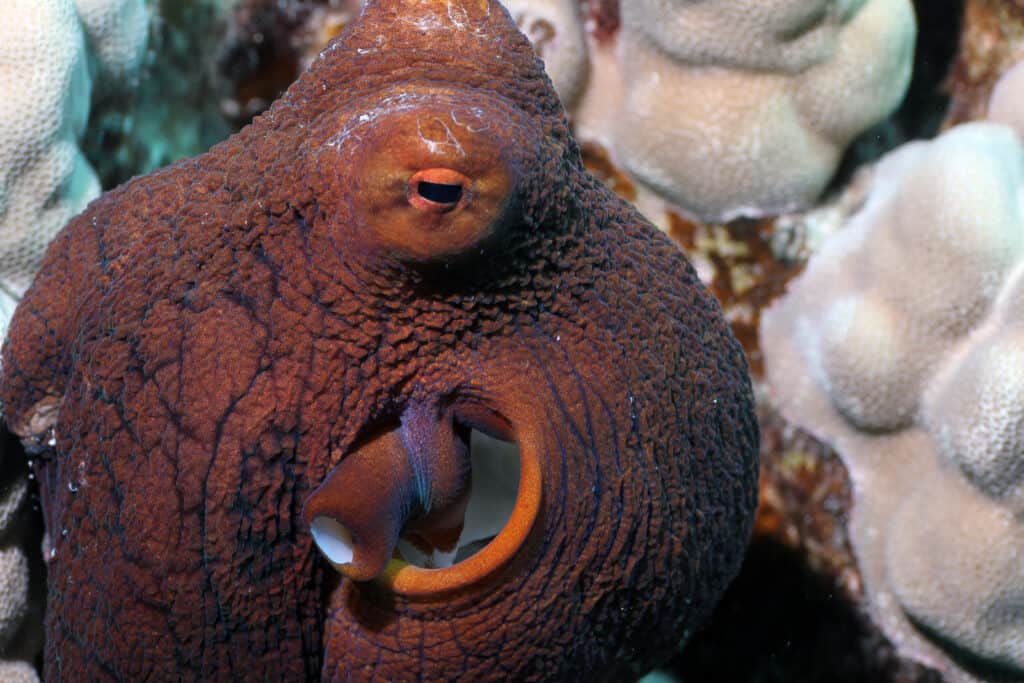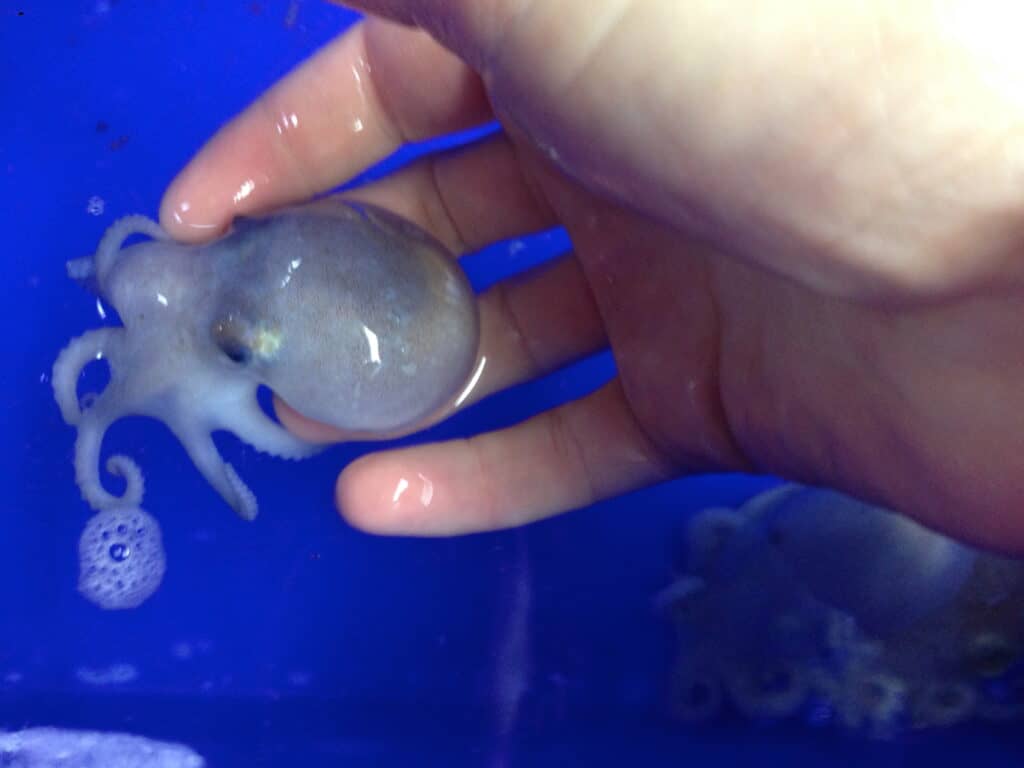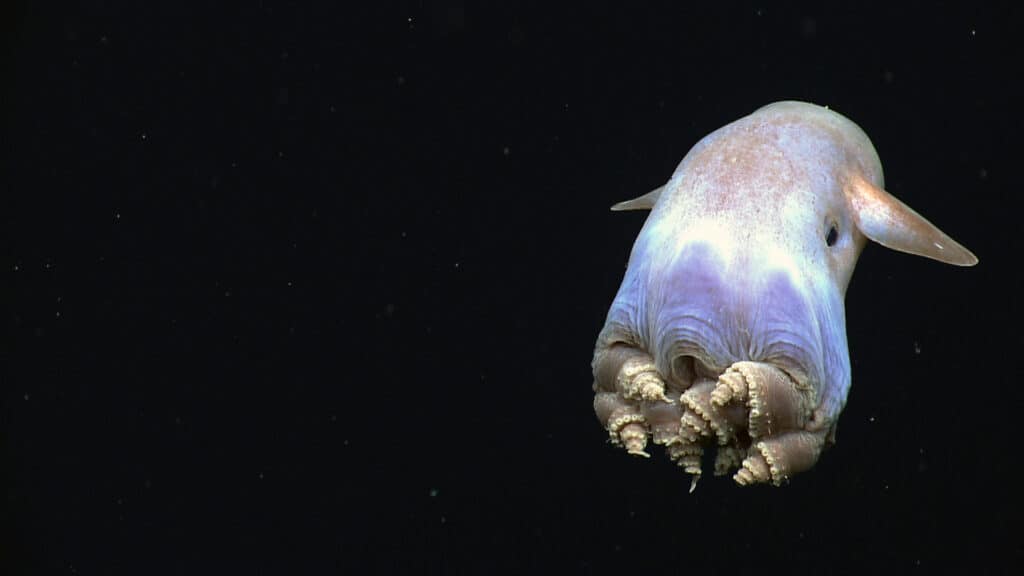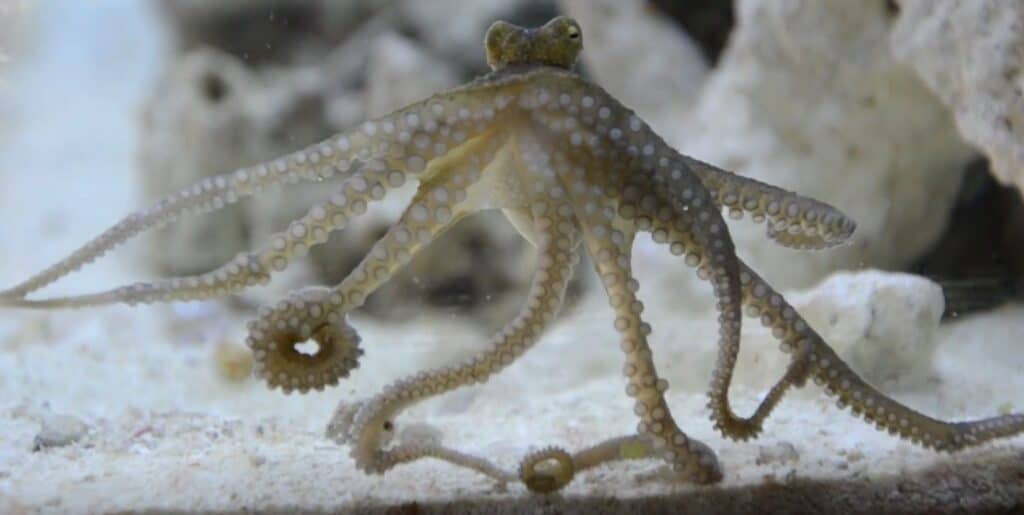Did you know that there are close to 300 different types of octopuses? Octopuses are invertebrates of the Mollusca phylum that are closely related to squid and cuttlefish. An Octopus has eight limbs, two eyes, a soft body, and a mouth with a hard beak. Its mouth is located in the middle of its body. An octopus has a siphon that it uses for breathing as well as for expelling a powerful jet of water, which helps it to move quickly. Octopuses are highly intelligent creatures, with complex nervous systems and incredible vision.
Octopuses are some of the planet’s most intelligent invertebrates They are able to recognize faces, and they express emotions by changing color and texture. Research has shown that octopuses can solve puzzles, use tools, plan ahead, strategize, and open complex locks.
Ocean dwellers, octopuses are highly adaptable to many marine environments, from tide pools to deep-water habitats. Read on to learn more about these captivating creatures.
Hawaiian Day Octopus (Octopus cyanea)
The day octopus, also known as big blue octopus and the Hawaiian day octopus is a fascinating creature that makes its home in the Pacific and Indian Oceans and lives on coral reefs. Day octopuses get their name from their habit of hunting during the day, using their amazing ability to blend in and change colors and skin patterns to sneak up on their prey. The day octopus can change its color more than one thousand times per hour!
The day octopus’ diet includes fish, shrimp, and crabs. Day octopuses have a cooperative relationship with the roving coralgrouper. These two marine animals’ natural characteristics complement each other when hunting prey. While groupers are lightning fast, octopuses can flush out prey with their long tentacles.
Hawaiian day octopuses live for a year or two, and weigh about fourteen pounds.

The day octopus can change its color more than one thousand times per hour!
©Marty Wakat/Shutterstock.com
Spoonarm Octopus (Bathypolypus arcticus)
The spoonarm octopus is also called the deep sea octopus or North Atlantic octopus because it lives primarily in the Northern Atlantic Ocean
The spoonarm lives at a depth of between 500 and 2000 feet, preferring water temperatures of under 50 degrees Fahrenheit. Scientists have discovered these octopuses in water as deep as 5,000 feet!
The spoonarm octopus isn’t very big, growing to only four inches long, weighing less than one pound! They have eight short arms that are of unequal lengths that are spaced in an irregular pattern around its body. These octopuses do not have ink sacs (most deep-sea octopuses don’t).
The spoonarm octopus’ diet consists almost exclusively of brittle stars, though they eat crustaceans, worms, and bivalves, as well.
Spoonarms live for up to six years.

The spoonarm octopus isn’t very big, growing to only four inches long, and weighing less than one pound!
©[[File:Fis01052 (28092271941).jpg|Fis01052_(28092271941)]] – License
Dumbo Octopus (Grimpoteuthis)
Dumbo octopuses are also called umbrella octopuses because of their unique shape. They are named after the Disney character Dumbo, an elephant with big ears. This description is pretty accurate, as the dumbo octopus has large fins that stick out on each side of its head like ears.
Like most other deep water octopuses, the dumbo octopus does not have an ink sac and cannot change color.
Dumbo octopuses live at depths of 3000 to 22,000 feet and research suggests that they are capable of adapting to a wide array of environments.
Dumbo octopuses primarily subsist on bivalves, worms, and crustaceans. They rest on the sea floor with their arms wide open, waiting for unsuspecting marine animals to swim into their trap. Once it has been snared, dumbos close their arms around the prey and move it into their mouths.
The dumbo octopus can breed at any time of the year and likes to attach its eggs to rough coral in the deep sea. Though most octopuses guard and protect their eggs, dumbos don’t, perhaps because their eggs are large and have tough casings. Dumbos live for three to five years.

The dumbo octopus has large fins that stick out on each side of its head like ears.
©[[File:Dumbo-hires.jpg|Dumbo-hires]] – License
Algae Octopus (Abdopus aculeatus)
The Algae octopus is no bigger than a pool ball or small apple, reaching only 2.7 inches in diameter; its eight legs less than ten inches long. The algae octopus gets its name from its expert camouflage skills. These little invertebrates blend in so well with the sea floor that they are rarely visible unless they are moving. Algae octopuses are also known for being able to walk while they are chasing their prey, utilizing two of their eight arms.
Algae octopuses live near coastlines and prefer to stick to the intertidal zone. This area, near the shore, is underwater at high tide, but exposed to the air and sun during low tide. You will find algae octopuses in the same tide pools as sea urchins and sea stars.
The algae octopus hunts during the day and stays in its den at night. They eat tiny crustaceans, like crabs. They are very fast due to their light weight and use propulsion to chase their prey during high tide in addition to swimming and bi-pedal walking.
Algae octopuses have a complex mating ritual in which the males and females build dens next to each other. The male then reaches his mating arm into the female’s den. They mate many times over the course of a week and produce thousands of eggs. The lifespan of the algae octopus is unknown.

The algae octopus hunts during the day and stays in its den at night.
©Creative Commons Attribution-Share Alike 4.0 – License
Giant Pacific Octopus (Enteroctopus dofleini)
The giant Pacific octopus lives along the Pacific Coast. It likes to live in shallow intertidal zones, but can be found as deep as 6,000 feet.
The giant Pacific octopus weighs 33 pounds on average and their bodies are approximately two feet in diameter. The giant Pacific octopus is a master of disguise and can change colors in the blink of an eye. They are normally rust-red, and their appendages are covered with over two thousand suction cups. They are known for their exceptional sense of smell and taste.
The giant Pacific octopus eats shrimp, scallops, snails, fish, squid, lobster, and even birds and other octopuses! They prefer to carry their meals into their den to dine in private.
The giant Pacific octopus lives for three to five years. After mating, they lay up to 400,000 eggs. They attach the eggs to a hard surface and care for them until they hatch. The female blows water on them to remove algae and debris.

Gaint Pacific octopuses even eat birds and other octopuses!
©karen crewe/Shutterstock.com
Amazing Octopus Facts
- The spoonarm octopus will die if exposed to temperatures over 50 degrees Fahrenheit
- The spoonarm octopus is a permanent host for a parasite. The parasite lives in the octopus’s eyes!
- About two-thirds of an octopus’ neurons are located in its arms. That means they can taste and feels with their arms and control each limb independently.
- Octopuses have three hearts and blue blood!
- Octopuses can change their color and skin texture in under one second.
- Many octopuses have ink sacs to use as a defense mechanism. They spray a cloud of black ink into the water and speed away.
- Octopus can regrow a damaged limb.
- Scientists believe octopuses are conscious, sentient beings that can feel pain and actively try to avoid getting hurt.
- Some octopuses are venomous.
- According to the fossil record, octopuses have been on the earth since 296 million years ago.
NEXT UP:
The photo featured at the top of this post is © Olga Visavi/Shutterstock.com
Sources
- wikipedia, Available here: https://en.wikipedia.org/wiki/Giant_Pacific_octopus#cite_note-25
- archive.org, Available here: https://web.archive.org/web/20200826120916if_/https://www.discovermagazine.com/planet-earth/through-the-eye-of-an-octopus
- eol.org, Available here: http://eol.org/pages/593207/details
- nature.com, Available here: https://www.nature.com/articles/ncomms2781
- (1970)
- (1970)
- (1970)
Thank you for reading! Have some feedback for us? Contact the AZ Animals editorial team.






